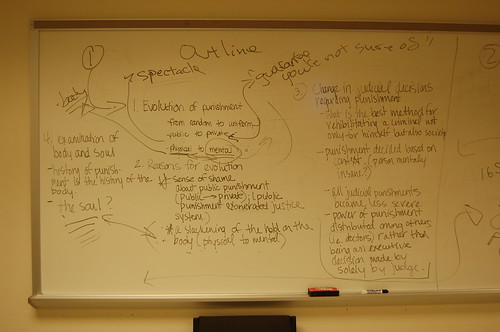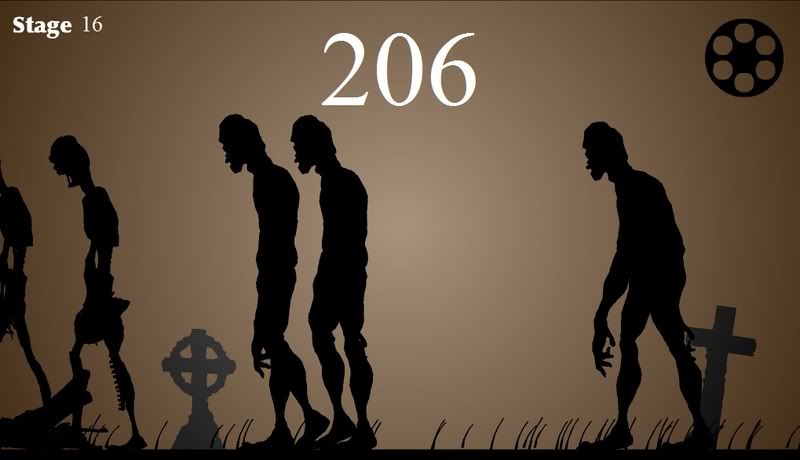
OK, so last night’s class was so inspiring (a.k.a. sick) that I thought I would blog about it right quick. I have been leaving traces of some of the resources I have been finding on YouTube, and alluding to some ideas about categories, tagging, and WordPress -but last night demonstrated a couple of amazing things for me. The image above is the last “physical’ remnant of an amazing discussion about the first chapter of Michel Foucault’s Discipline and Punish, “The body of the tortured.” This chapter is, in many ways, a twenty-eight page outline of his overarching argument throughout the rest of the book, he defines the terms of transformation for crime, criminality and the penal system as well as his methods and notion of body, soul, power, knowledge and genealogy. Amazing stuff, yet for the last ten to twelve pages this chapter is intensely dense and abstracted to conceptualize the fields of power in relationship to the im/materiality (a necessary forward slash) of something he terms the “Soul.” In fact, an extremely difficult concept that walking in to class I was not certain I could entirely get my own head around, no less articulate intelligently. I’m glad I wasn’t alone in working through this text! In effect, the discussion was a distributed space of attempting to work through his argument using the tools to define the overarching points he outlines throughout the chapter, as well as a focused close reading of particular sections of the text.
But this post is not about how well the class went (well, it is, but not really) or how good a teacher I am (well, it is, but not really), yadda, yadda, yadda, it’s about an approach I stumbled upon while discussing the notion of history, categories, and generalizations with my wife, Antonella. The approach is quite simple: have the students respond to each and every reading through the class blog by selecting three or more categories that define their understanding of the text, then they need to explain their choice of this category (which is wide open) with a close reading (read more about the approach here). Simple enough.
While preparing for class yesterday and foregoing an awesome conversation with Laura Blankenship and a whole host of folks from Faculty Academy, I started to think about how I was framing (through my “lecture” notes) my own reading of this chapter (you can see them on the class syllabus/wiki here) according to a very structured notion of his argument. This approach was the very thing that would provide me a way to start talking about this insane text in some orderly, syncopated fashion. So, it dawned on me that they have all done the reading, they have created their own categories independently on the blog about this reading, why not ask them to take the first 20-30 minutes of class and do something similar. Can they together, as a class, outline the argument Foucault is making throughout this chapter on the board? I asked them as much, left the classroom for a half an hour, then came back -and wow! I have never, ever, in my now eight years of college teaching had a groovier experience in my life.
What you see in the image above is an outline (a trace) that they created together and thereafter were each asked to explain its logic at some length. What is the trajectory of the chapter, where is the evidence for this reading, what do you think Foucault means by “loosening hold upon the body?” How do we understand the notion of body in this text in relationship to what he terms the soul? What is the “medico-juridical complex”? It was all there, I wish the outline on the board was even more indicative of the rich, brilliant discussion that emerged from them explaining their readings to me, both individually and as a class. I was blown away, everyone was engaged, everyone had something to say, and the argument/reading was theirs -I couldn’t help from chiming in because I wanted to play too!
Moreover, the class ended in an epiphany of light when one student reading the following two lines quite closely and beautifully summarized our entire discussion, “A ‘soul’ inhabits him and brings him to existence, which is itself a factor in the mastery that power exercises over the body. The soul is the effect and instrument of a political anatomy; the soul is the prison of the body.” I fumbled around to do the teacherly thing and rephrase it, but couldn’t -she nailed it! She framed and summarized the class better than I ever could have. And, me, well I was all fired up. So fired up I had to go and find a camera and take a picture of the white board to remind myself of this class for a long, long time.
What does this all mean? I don’t know exactly, and the class is still young and things could still flop (I’ve had one of them all too recently!). For the moment, however, my thinking about language, categories, definitions, tags, and taxonomy more generally due to my work in instructional technology and a general engagement in the concepts and issues surrounding the questions of knowledge, relations of power, the body, and the “soul” in this fascinating line of work made me a much better teacher and student, at least for an ever-fleeting two and a half hours.

 Doing some last minute prep for class this evening I stumbled across an interesting fact about the iconic early American minister
Doing some last minute prep for class this evening I stumbled across an interesting fact about the iconic early American minister 







